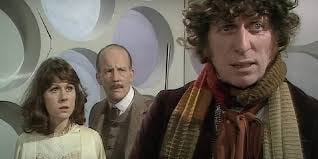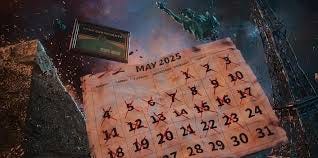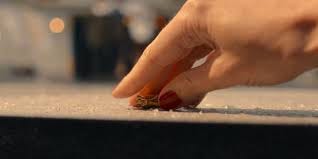The New Rules Of Time Travel In Doctor Who, in "The Little Bootie-Strap Paradox"
Have I been over thinking things again?
Doctor Who, for a programme about time travel, has made remarkably few changes in the timeline. Indeed, from the beginning, it was a no-no. The Companions are told by the Doctor that one doesn't change established history. The first time we met another Time Lord other than the Doctor or Susan was the Meddling Monk from 1962, the show's first returning villain. He had already changed Earth history to the one we know, in Medieval times, but the First Doctor stopped him from making any more. And so the Doctor would do his best not to change history, even as he became a part of established events. Which brought the accusation that it was only established Earth history that the Doctor didn't change. Earth’s future history, or what happened on other planets, was fair game for change, deposition, revolution, whatever. But also, there was a lack of jeopardy in the past if history couldn't be changed, such as when some alien race was going to destroy the Earth (again). It took Sarah Jane to ask the Fourth Doctor, in the Pyramids Of Mars, why they were so concerned about Sutekh's actions in the 1920s if the Earth was fine in the 1980s, where she was from. The Doctor jumped them both forward in the TARDIS from the 20s to the 80s to show her world destroyed, a sea of eternal sand, where she had never been born. It re-established that jeopardy. Time could, and would be changed by nefarious forces, if the Doctor didn't stop it.
The revival of Doctor Who also took this tack. Timelines couldn't be changed, or there would be consequences, such as in the beautiful Father's Day, or there were fixed temporal loops, such as in Blink. These stories, by Paul Cornell and Steven Moffat, went into the time-wimeyness of it all, something Russell T Davies generally avoided in his stories. And when Moffat took over, there was nothing but time loops, from the reverse story of River Song, the reworking of his classic Doctor Who short story from Decalog 3 into A Christmas Carol, having the Doctor talk to camera about the bootstrap paradox and giving us self-forming loops in Time/Space, Time Crash and the recent Joy To The World.
But with Russell T Davies' return with the Disney+ run, it seems that after eschewing such plots for himself, he wants a go. But because this is RTD, he wants to do it with all the feels.
The return of David Tennant as the Fourteenth Doctor saw something change. At the far end of the universe, the Doctor breaks reality, bringing in the gods from outside who would then plague him, from The Toymaker to The Maestro, to Sutekh to Lux, bringing back fairytale logic and magic, but also triggering something new. Time can now be changed, and it sticks. The first sign, happening retroactively, is messing with Isaac Newton and having Donna accidentally make Newton rename gravity as “mavity”. And this has stuck, even in this week's Eurovision song contest with the space station's mavity bubble. For some, it's a running gag; for others, it’s a sign that history can now be changed.
Ruby Sunday, coming on the scene, was a sign of that. Her trip to prehistory saw her step on a butterfly and turn all of humanity into a warlike insectoid species for a few seconds until the Doctor could bring the butterfly back to life. And in The Devil’s Chord, set in the sixties, the Fifteenth Doctor did the same trick he did with Sarah Jane, showing her an apocalyptic present day courtesy of the Maestro, if left to their own devices.
But Ruby Sunday could open reality across time and space up to the day she was left as a baby on the doorstep of a church. The snow fell, the singing choir from inside flowed through her, and she was a walking, talking time event. In 73 Yards, she managed to create an entire bubble universe around her with her future self kept at bay by the size of the field of the TARDIS (66 metres, established in The Church in Ruby Road, now focused somehow on her. All that went away, of course, as the time bubble was popped. But it was there, time was changed.
Also in The Church in Ruby Road, just as Sutekh could change the timeline the first time the Doctor met him, he could do the same again, reducing the Earth's population to sand, even as the TARDIS's travels somehow managed to preserve aspects of history, only for it to be repeatedly reduced to ash.
But then there was Ruby Sunday's history, who grew up living next door to Time Lord, The Rani, we were told that what had been recorded on that VHS tape was also changing in real time. The UNIT Time Window opened up on that day at the church when the TARDIS visited, and Ruby Sunday was left as a baby on the church steps by her mother. Much of that episode was focused on Ruby, her mother and father being ordinary, swept up in events. But it ignored much of what happened with Ruby, with the snow and the songs.
In my head, the UNIT Time Window, the TARDIS, the memory TARDIS and Sutekh all being there, turned Ruby Sunday into a living time window. And the reason that the UNIT Time Window was able to operate so well then, and why the TARDIS and Sutekh were drawn to her, is because Ruby Sunday was a living time window, by her little wee bootie-straps. Everything else tumbles out of that event.
And now in Season Two, we have a new event. The destruction of the Earth on the 24th of May. An event that has been timelocked so that the TARDIS can't approach it. The last time this happened was in New York in the 1920s, when the TARDIS and Weeping Angels broke it so much. And there is a complicated time event that led up to that date as well. And set up in The Robot Revolution.
Five thousand years ago, Belinda Chandra's starchart, given to her by her ex-boyfriend Alan, finds its way to a planet in the star system it was meant to name, which renames itself Missbelindachandra One. Robots from the planet's future then arrive with Alan, who takes over the world, and are then commanded to capture his ex, Belinda Chandra, from Earth. Who, like Ruby Sunday, lives next to The Rani. Which, on the 24th of May, is what they do. On the way back, as part of an unexplained timeslip, she commands some of the robots to capture Alan instead of her, which they do, just years before, by their bootstraps. Leaving Earth, we see it as rubble, with her star chart floating in space, waiting to be picked up and sent back to the far past.
Since then, we have discovered in The Well that the human race no longer exists and has been forgotten by the future. In The Interstellar Song Contest, we learn that the Eurovision Song Contest was sifted from the remains of Earth, as it seems were the memories of Graham Norton and the frozen body of Rylan Clark. The Earth was destroyed on the 24th of May, 2025. Next Saturday.
Oh yes, and the Doctor only met Belinda Chandra because Conrad mentioned her to him. And Conrad only knew Belinda Chandra because he met her, travelling with The Doctor. Another loop.
Was this the Rani's doing, who has been seen across time and space where the Doctor and Belinda have been travelling, as Mrs Flood (Rain=Rani)? Just as the original Rani did, she does love dressing in clothes modelled on the Doctor's companions. Is she responsible for changing the rules of time, or has she just been exploiting them? An amoral scientist of a Time Lord, what is her game plan? Will the Doctor defeat her and manage to reset the rules? Or will he decide that, actually, things are more fun – and there is more jeopardy – keeping things this way?
The Doctor left his granddaughter, Susan, in the 22nd century on Earth after a Dalek invasion, with her then-new boyfriend David Cameron (I know), promising to come back but never doing so. A rather cavalier approach given that Susan had known David for a couple of days at that point. Might that come up perchance?
Would it be too much to ask for Michelle Gomez to join them all? It seems at this point that it must have been the Rani who took the Master's gold tooth from the remains of the Toymaker. The Rani, Susan and The Master might make a fun Trinity... even if there are two Ranis amongst them now.









